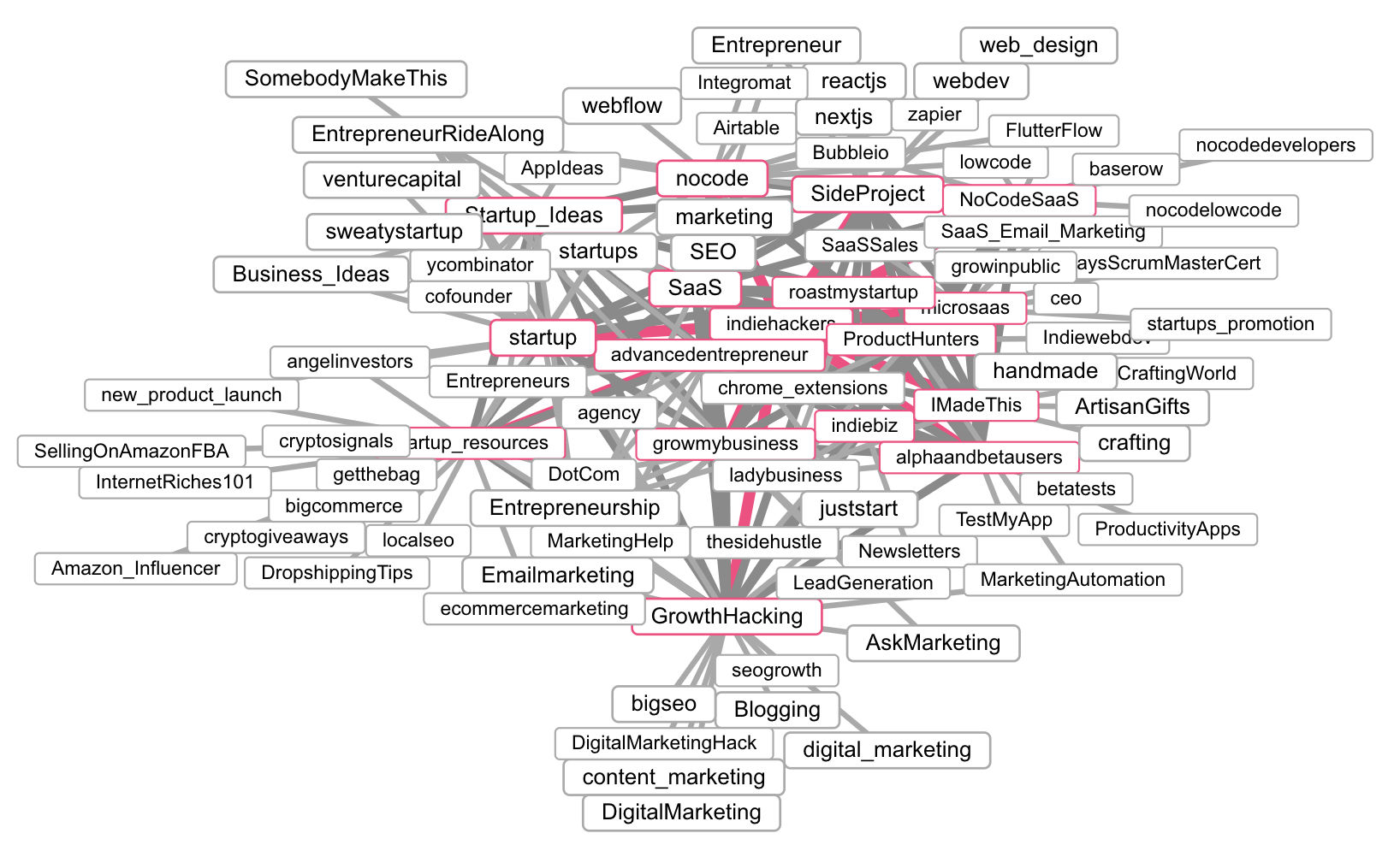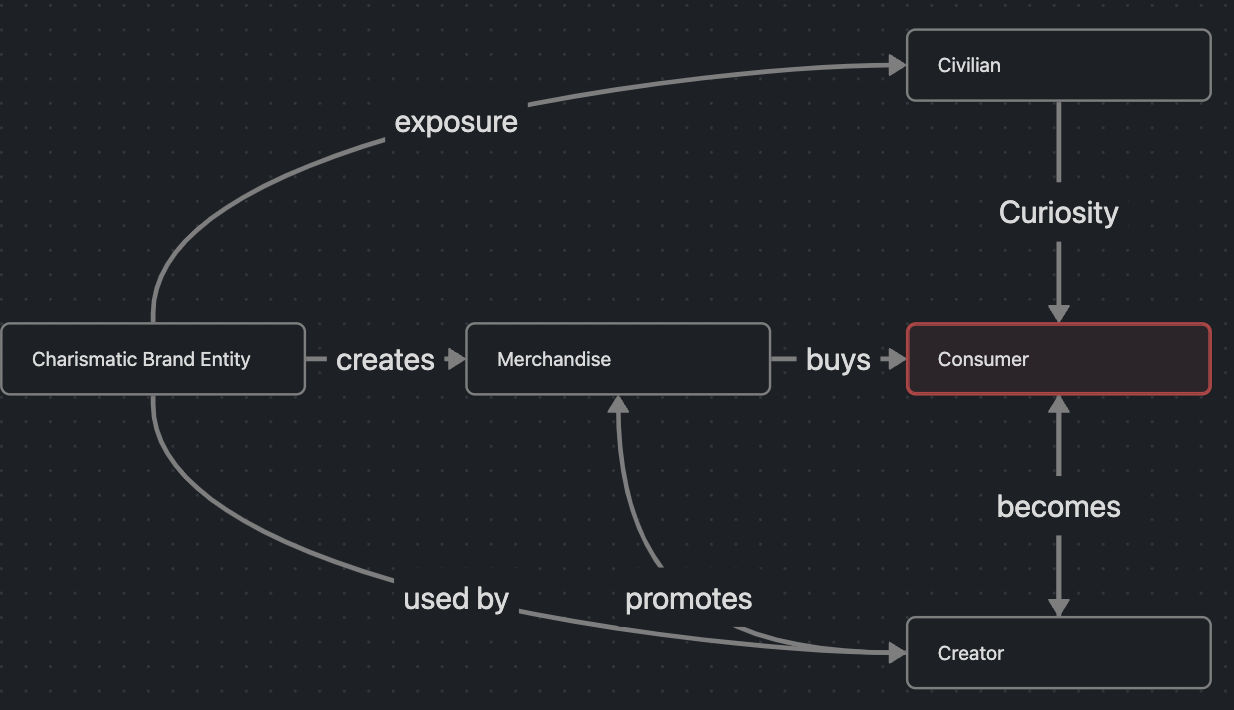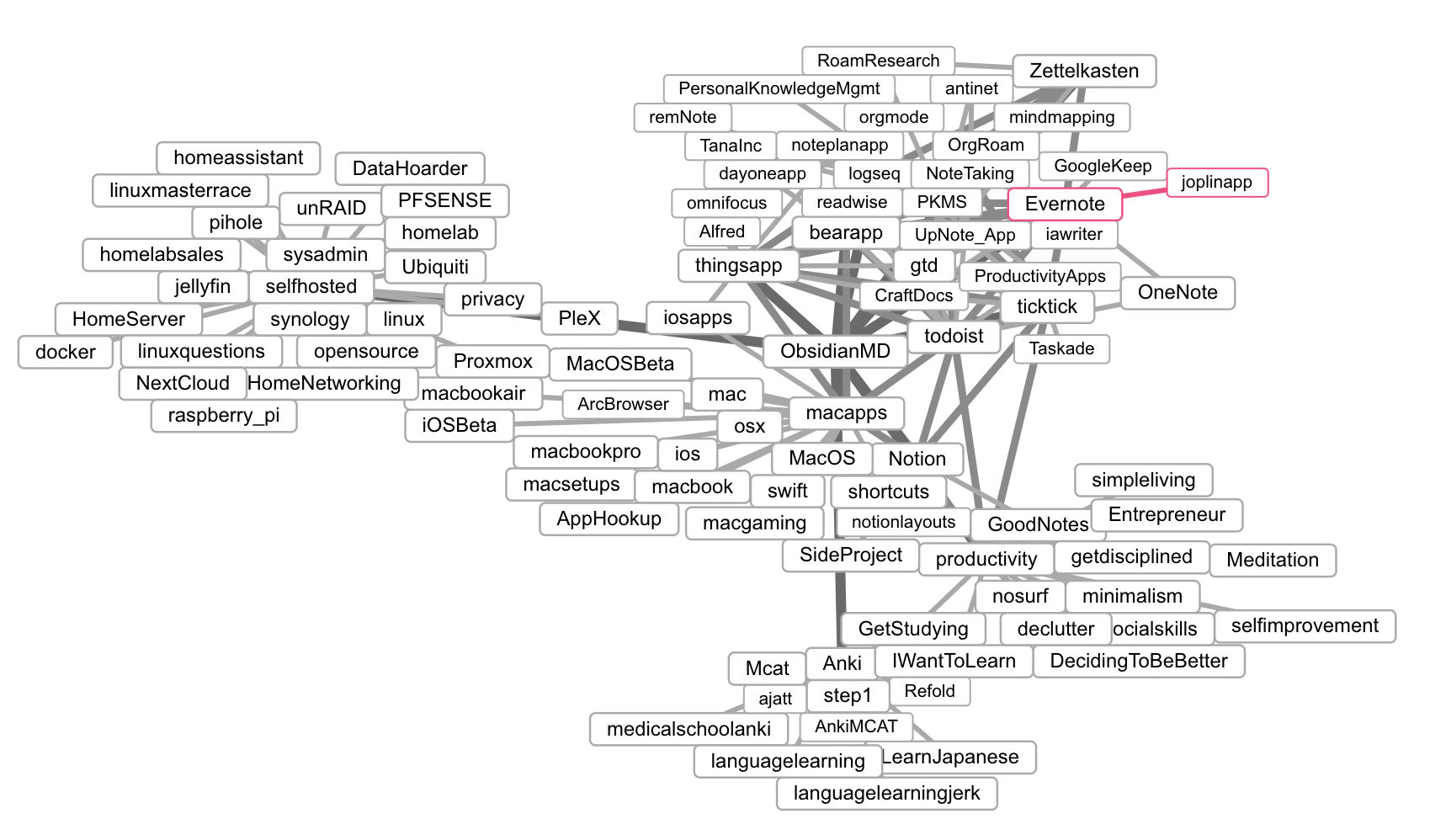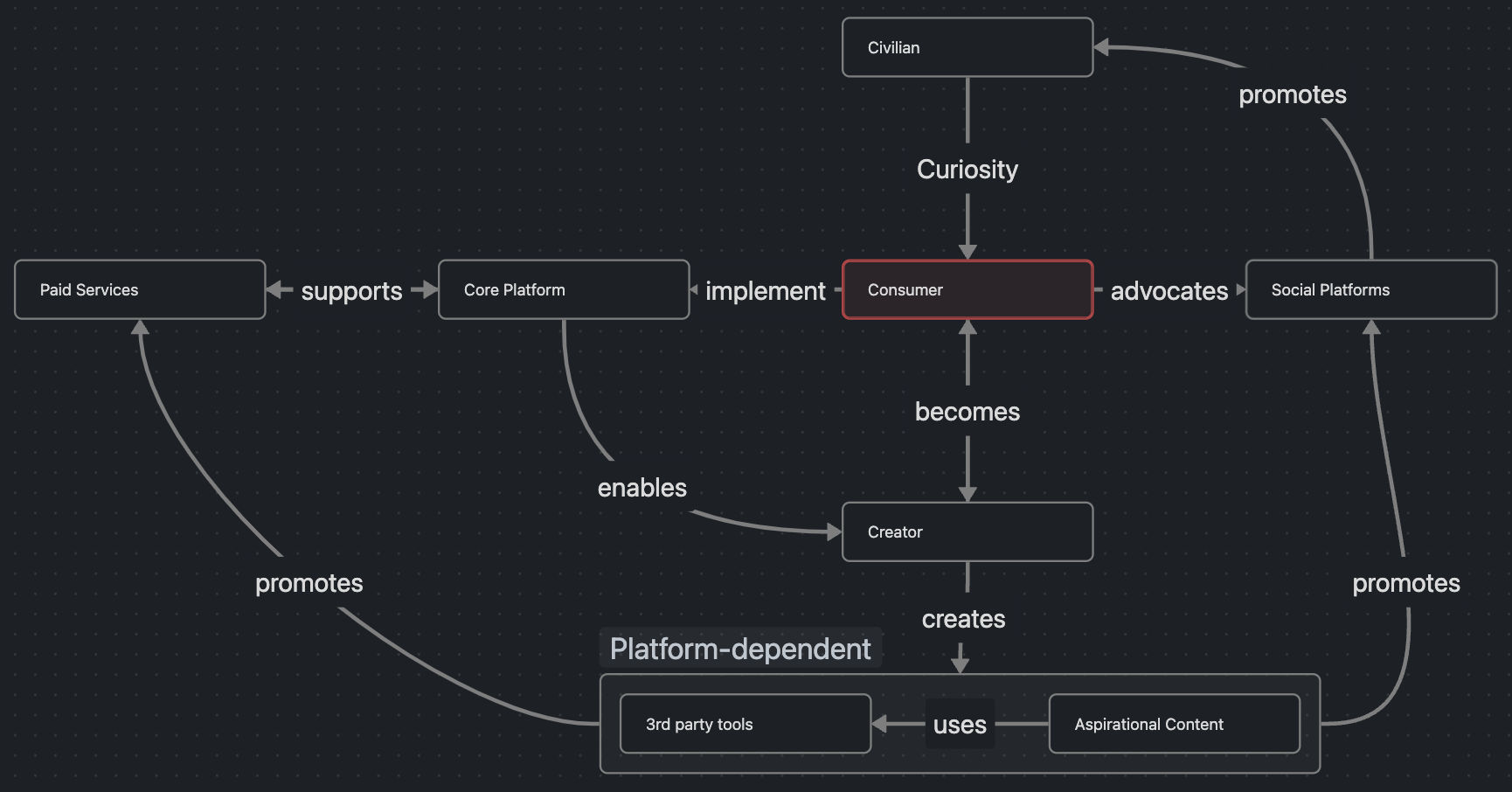Mining Towns

For the last 20 years, we've all been getting mapped by machines. Global (who am I kidding? American) wealth has been dramatically shaped by this reality, and politics, identity, career, and opportunity are the fallout. There's a purely extractive model to this mapping, as well as a constructive model. Both take — probably more than they give back. And while both are net negative, but I think the latter might have some human value.
Usually, this mapping is extractive via "attention economy" mechanics, where every mL of attention is being enthusiastically squeezed out our frontal lobes. This is the mined resource that powers the growth of software startups, the mentality of customer acquisition and churn, and the reality that most of us become captured by platforms that are just advertising platforms masquerading as communication tools. The grand bet that Meta took over the past few years is an even deeper mining of that attention via virtual reality. The new bet is that dumping all of our energy resources into GPUs will leverage (and refine) our attention, emotions, and time even more heavily. If the raw crude is all tapped via social media, let's get into that high pressure fracking slurry — and make sense of it after.
Then there's the constructive model of mapping. And I don't mean constructive in the positive "that is a constructive comment." More in the "pertaining to the activity of constructing" way. This is frequently of YouTube and Reddit, where individuals self-select into communities and a funnel of curiosity to interest to language to participation to identity is traversed. Throughout this whole process, micro-economies of purchase decisions, low-effort product, niche services, and thematic merchandise emerge. Sometimes organic (passionate participant creations, Etsy crafts), other times manufactured (drop shippers, market hunters), sometimes in between (fandoms). The important thing about the constructive model is not so much that products are coming out of it: it's that the "mapping" taking place is manufacturing a new consumer within that milieu by moving them through this funnel. What's interesting is that sometimes that consumer becomes a creator.
There are different ways to refer to this identity construction. I mentioned the curiosity-to-identity flow, but bumping up a layer of abstraction, I think these types work:
- Civilian: Someone who is not part of the community or "fandom". They might have curiosity and maybe some passing interest, but things stop there. I'm a Civilian when it comes to basically any pro team sport.
- Consumer: Someone who consumes the output of the community, is usually "mined" for value in some way, and isn't actively contributing to the community through new making. This is most people with an interest or hobby. Consumers are invested, but often from a "sunk cost" perspective. I'd be a Consumer on the "food science/history" side of things.
- Creator: Someone who is actively creating within a community, but not necessarily profiting from their creation. Many communities have a very "low" threshold to creating, eg. anything that involves creating "fan art" or vulgar craft in a likeness of something. Importantly, creators tend to be "super consumers" as their participation enhances and reinforces investment in the community. I'm a Creator in the ... whatever this is? gestures community side of things (newsletter, projects, etc).
Let's look at four of these "constructive" communities where civilians get "mapped" by moving them through these flows. I'll start each one with a "map" of adjacent communities, force projected for your social way finding pleasures. A brief description, and a breakdown of some key traits. I'll then attempt to describe the structure as I see it, and represent that structure with a graph.
Indiehackers
https://anvaka.github.io/sayit/?query=indiehackers
 IndieHackers is an owned community site, but is broadly a group of solo, mostly technical makers of projects that are wired up for making money. I was (am?) one of these people with Knowsi, Pedal Pedal Club and Stupid Fits — though Knowsi was the only one that made money.
IndieHackers is an owned community site, but is broadly a group of solo, mostly technical makers of projects that are wired up for making money. I was (am?) one of these people with Knowsi, Pedal Pedal Club and Stupid Fits — though Knowsi was the only one that made money.
Key Traits
- Classic e-myth revisited technicians -> Technical/makers seeking independence
- Lifestyle vs hustle culture tension (4hr work week stuff)
- Overlap with the "Digital Nomad" community
- Content is basically performative success ("got to so-and-so ARR in 37 seconds on ProductHunt"), performative failures ("what I learned from 65 failed SaaS businesses"), or requests for assistance/feedback.
- Community is overwhelmingly affluent, male, and technical.
Structure
- Captures attention through a lifestyle promise and appeals to dissatisfied technicians (e.g. engineers at larger companies). These consumers are "transformed" into creators (or pseudo creators) through the community, which serves to feed the monetized platforms.
- MANY of the success stories in this space are people who created a business out of serving this aspirational community. Coaching, courses, bespoke communities, paid newsletters, etc. Very MLM.
- Capital is flowing into this community from aspiring indie hackers who are working on a side hustle while employed OR who have recently quit a role and are seeking guidance.

Vocaloid
https://anvaka.github.io/sayit/?query=vocaloid
 I've been playing with a vocal synth called Synth V recently, and had to wade through some weird youtube tutorials to figure out how to use it (though this song is great — top comment being "Making an anti AI song with a Vocaloid artist goes unfathomably hard").
I've been playing with a vocal synth called Synth V recently, and had to wade through some weird youtube tutorials to figure out how to use it (though this song is great — top comment being "Making an anti AI song with a Vocaloid artist goes unfathomably hard").
Vocaloids are vocal instruments that synthesize a person singing via a combo of synthesis and sampling. Originally sold as "backing vocals" (like the 303 was as a bass track for guitarists), they ended up being marketed via digital avatars meant to represent the synthesized voice, with their own fan bases growing around those characters. It got as far as David Letterman (who looks like he wants to strangle his producer).
Key Traits
- Synthetic but charismatic brand entity/avatar is the focus, vs. the technology
- Corporate brand owners leverage consumer interest to sell merch
- Heavily online fan base and international — though focused in Asia.
- Low barrier to entry for creative software, with lots of fan creations as a result. Several very talented producers write songs with Vocaloid, e.g. I thought this one was quite clever.
- Fan content is attributed to the avatar, and often organized by it
Structure
- Basic User-Generated-Content brand capture loop.
- Civilians are exposed to some kind of charismatic brand entity, get curious, and are pulled into a consumer-to-creator funnel.
- Creators generate content that reinforces the brand entity's surface area and exposure
- The copyright holders of the brand entity create merchandise and products tied to brand and encourage consumption.

ObsidianMD
https://anvaka.github.io/sayit/?query=obsidianmd
 Obsidian is approached as the mechanism for "personal knowledge management", a response to information overload. Imagine forgetting a section of a book you read a year or two ago. Instead of re-reading the book and moving on with your life, you put on your game face and decide that you're never going to lose again. That's PKM.
Obsidian is approached as the mechanism for "personal knowledge management", a response to information overload. Imagine forgetting a section of a book you read a year or two ago. Instead of re-reading the book and moving on with your life, you put on your game face and decide that you're never going to lose again. That's PKM.
Essentially, Obsidian takes an IDE approach to your word processing tool, and while I personally love it — it made the short list for this post very quickly when it came to "constructive" qualities within its community and business model.
Key Traits
- Seemingly simple toolkit that is massively customizable — and therefore amplifies complexity.
- Users trying to solve information/aspiration overload with software (looking at the map, you can see examples of language learning, note-taking, PKM, etc)
- Aspirational minimalists with maximalist dispositions
- Technical competent user base, but mostly not engineers
- Broadly online, often in academia or knowledge work, and coming from other software (Evernote, bear, etc).
Structure
- The Core Platform itself is free, and enables creators to build plugins on top of it. Plugins incentivizes consumers to get locked in to the Obsidian way of doing things (the investment/sunk cost trap of the consumer), even though the data format (markdown and folders) isn't locked in.
- Obsidian as a company has limited monetization of its community — but may be holding off for fear of chasing users off the platform. It essentially holds a monopoly to set the terms of its extraction because it owns the core platform.

Bitcoin
https://anvaka.github.io/sayit/?query=bitcoin
 Not sure how much I need to explain Bitcoin here. Putting my own politics on the table: I have a fair bit of optimism re: cryptocurrencies and protocols as a technology, but have a lot of skepticism around the capital markets and actors surrounding it. Ponzi schemes aside, the connection between the cryptocurrency technology cluster and /r/wallstreetbets is worth noting.(Obviously, if you click on this, PLEASE do not take any advice or make any kind of investment based on anything you see here).
Not sure how much I need to explain Bitcoin here. Putting my own politics on the table: I have a fair bit of optimism re: cryptocurrencies and protocols as a technology, but have a lot of skepticism around the capital markets and actors surrounding it. Ponzi schemes aside, the connection between the cryptocurrency technology cluster and /r/wallstreetbets is worth noting.(Obviously, if you click on this, PLEASE do not take any advice or make any kind of investment based on anything you see here).
Key Traits
- A core technology that requires time investment and some prior knowledge to actually understand
- A relatively high barrier to entry because the tech building blocks are built around a fundamentally different infrastructure and protocol
- FOMO driven investment by both tech-savvy and consumer tech folk
- Community driven by "true believers" and a formalization of "true believer" status through various protocols (e.g. NFT access to private discords)
- Meme-savvy creators leveraging culture and the possibility of wealth to attract new consumers/creators
Structure
- This one felt like the truest "loop" in the constructive/extractive model. Essentially Civilians end up gambling, consumers end up investing, and creators end up leveraging the core protocol around which the ecosystem is defined.
- The platform itself creates a kind of hype-cycle which encourages progressively deeper investment in a particular protocol — with creators often "choosing a side" by focusing on one protocol or the other.
- At every step, every type of participant is incentivized to promote and "hype up" the protocol. Particularly those with investments — as well as true believers — only have downside if new participants fail to appear with new investments in the ecosystem.

Mining Towns become Ghost Towns
There's a lot of excitement in mining towns. They are typically frontiers; exciting and vibrant. People are working hard, things are getting made.
But mining towns don't last. Eventually attention drifts elsewhere, and those selling shovels or novelty Miku hard hats move on. The interest part of writing this post was trying to sort through exactly what KIND of extraction I was seeing.
Dona Meadow's Systems zoo is a perennially useful concept when looking at these interactions. If you've seen it once, you'll probably see it again — just maybe with feathers next time. Looking the Bitcoin example, I wonder how much of the hype flywheel might apply in the Wallstreet Bets community? Would we find the same "UGC extraction" model of the Vocaloid communities replicated in other creator communities, like say Cricut or Midjourney? (Seriously people, avoid kits).
What makes me anxious is a future where we flit from community to community — swept along as the algorithm tries to pull us and our credit cards under. There's no place in that world to take up roots, and being trapped as an attention-ally (not a word) fragmented consumer is not a life where one can really know themselves.
The Indie Hacker and Bitcoin examples seem dangerously slippery in that regard — growth-oriented communities that predates upon the unwary and doesn't give anything in return unless the prey learns to leverage the system itself. In comparison, the Obsidian loop seems a healthy one — minimally extractive with an ecosystem-conscious extractor building the community's engine. Maybe the Vocaloid one is fine — a benign parasite attached to a low-stakes system.
Still — there is some good to come from this mining town. In each of these cases, communities develop. Even if the entry point to a community is one that is artificial or predatory on the part of the corporation, consumers and creators who find themselves ensnared are at least with their tribe. The amateur Vocaloid producer making bitrotted pop covers isn't creating for me, but for themselves and others in their "constructive" community. On the Obsidian side, I did the same with rehype-jsoncanvas — making a small contribution in a community of people trying to make sense of too much going on. Creating within a community is a wonderful thing, even when there's a cost. Just know what that cost is.